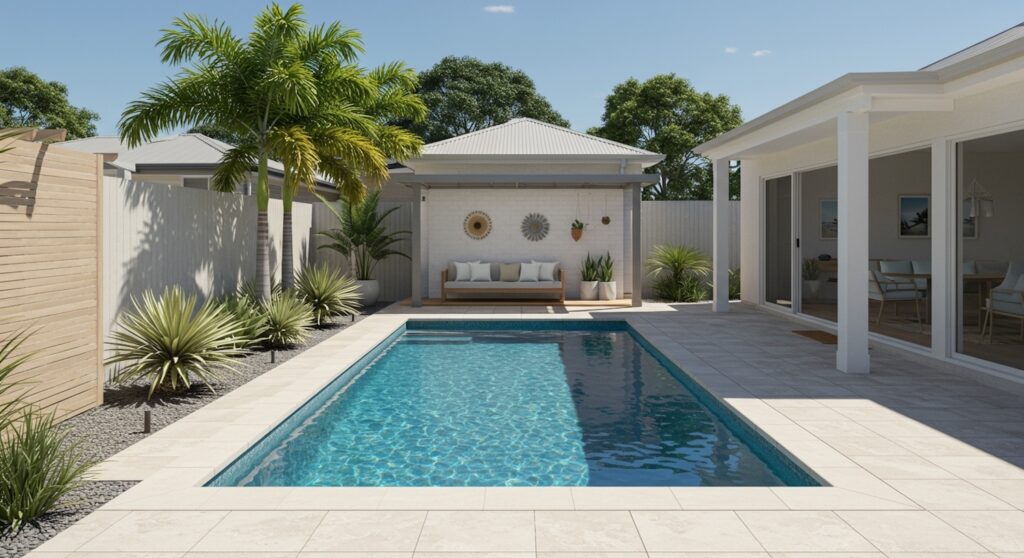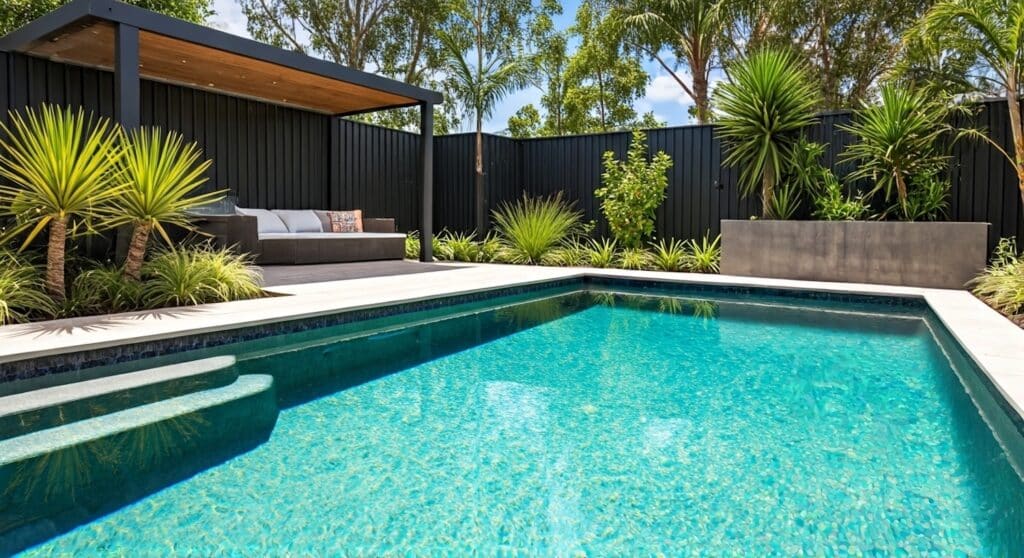Maintaining a concrete pool in Melbourne requires more than just standard cleaning—it’s about responding to the local climate, vegetation, water quality, and how frequently the pool is used. From leaf-heavy autumns in leafy suburbs like Ivanhoe, to the harsh summer UV in bayside areas, each environment presents unique challenges.
Concrete pools, while known for their durability, also demand specific care routines that evolve throughout the year. Understanding how pH levels shift with rainfall, or how wind patterns affect debris accumulation, can help homeowners build a smarter, more efficient maintenance plan.
This guide outlines the essential care tasks, seasonal adjustments, and long-term strategies that are specifically tailored for Melbourne pool owners. Whether you’re managing an older pool in Glen Iris or maintaining a new design in Brighton, these tips will help extend the life and beauty of your concrete pool.
Weekly and Monthly Tasks: A Melbourne-Focused Routine
Checking pH and alkalinity based on local water quality
In Melbourne, water quality can vary significantly from one suburb to another, especially depending on whether your property uses tap, tank, or a combination of sources. This affects both the pH and total alkalinity levels in your concrete pool—two factors that are critical to maintaining water clarity and protecting pool surfaces from corrosion or scaling.
Weekly pH testing is essential, particularly during summer when pool use increases and rainwater dilution can throw off chemical balance. Most Melbourne pool owners should aim for a pH range between 7.2 and 7.6, and keep total alkalinity between 80 and 120 ppm.
Because concrete is porous, it can gradually release calcium into the water, increasing pH over time. Regular adjustments using pH reducers or alkalinity balancers are key to keeping your system stable and your equipment functioning properly. Local pool supply stores often provide water testing services tailored to Melbourne’s conditions—an easy way to fine-tune your chemical routine.
Adjusting cleaning frequency for Australia’s seasonal shifts
Melbourne’s climate swings between hot, dry summers and cool, damp winters—with rapid changes in between. This variability means pool cleaning routines need to be flexible and seasonally adjusted to stay effective.
In summer, increased pool use, higher evaporation rates, and stronger UV exposure lead to faster chemical degradation and more debris accumulation. During this time, brushing the pool walls, skimming the surface, and vacuuming should be done at least twice a week, along with more frequent water testing.
Autumn brings falling leaves and more organic debris, especially in garden-heavy suburbs like Camberwell or Surrey Hills. Here, weekly skimming and filter checks become essential to prevent clogging and algae growth. In winter, when usage drops, maintenance can be reduced to biweekly tasks, but basic circulation and water balance still need to be maintained to protect the structure and equipment.
By aligning cleaning routines with Melbourne’s seasons, homeowners can reduce long-term wear and keep their concrete pool running efficiently year-round.
Debris and pollen: unique challenges in leafy suburbs like Ivanhoe and Canterbury
In tree-lined suburbs such as Ivanhoe and Canterbury, pool maintenance comes with an added layer of complexity: organic debris. Falling leaves, blossoms, bark, and seasonal pollen can quickly overload filters, stain pool surfaces, and disrupt chemical balance—especially in concrete pools, where porosity makes staining more likely.
During spring and autumn in particular, daily skimming may be necessary, and filter baskets should be emptied multiple times a week. Installing a leaf net or automated surface cleaner can help reduce manual work and protect your filtration system from overloading.
Pollen is another overlooked issue in these suburbs, often forming a yellowish film across the water. This fine material passes through standard skimmers, so using clarifiers or fine-micron filters is essential during peak bloom periods.
Proactive maintenance in leafy areas isn’t just about cleanliness—it’s about protecting the surface and extending the life of the pool’s finish, especially in older concrete basins where staining is more difficult to reverse.

Seasonal Adjustments for Melbourne’s Variable Climate
Melbourne’s four-season climate presents unique maintenance demands throughout the year. From high UV exposure and pool evaporation in summer to cold snaps and storm debris in winter, each season requires specific adjustments to keep a concrete pool healthy and visually appealing.
In summer, chlorine dissipates faster under intense sunlight, so chemical levels need to be checked more frequently—often every two to three days. Pump runtimes should be extended, and weekly brushing helps control algae growth on porous concrete surfaces.
Autumn introduces heavy leaf fall and temperature drops. This is the time to clean skimmer baskets more often, inspect filtration systems, and consider using a pool cover to minimise contamination. Water balance also begins to shift as rain and cooler weather affect pH and alkalinity levels.
Winter doesn’t eliminate maintenance; it just changes the focus. Even with less use, you should still run the pump daily, test water weekly, and keep surfaces clean to prevent long-term staining or calcium build-up.
Spring is all about rebalancing: removing debris, checking for winter damage, and preparing the pool for increased activity. A seasonal maintenance mindset helps extend the life of your concrete pool and ensures it stays ready year-round.
Pool Equipment Maintenance in Urban vs. Coastal Zones
Wear and tear on pumps and filters in coastal humidity (Brighton, Black Rock)
In coastal suburbs like Brighton and Black Rock, pool equipment is exposed to high humidity and salty air—conditions that can accelerate wear on pumps, filters, and electrical components. Even if the pool itself is well maintained, failing to adapt your equipment routine to the coastal climate can shorten the lifespan of key systems.
Salt spray and moisture can corrode metal parts, degrade rubber seals, and cause electrical panels to fail prematurely. It’s important to regularly inspect housing units, check for rust on filter connections, and ensure all electrical enclosures are sealed and elevated off the ground.
Using marine-grade stainless steel and weather-resistant materials for replacement parts is highly recommended in these areas. Equipment should also be sheltered where possible, either with enclosures or pool houses, to reduce direct exposure.
Routine checks and proactive replacements in coastal zones can help you avoid system failures and keep your concrete pool running efficiently, even in Melbourne’s harshest microclimates.
Preventing corrosion of metal components
Corrosion is a long-term risk in any concrete pool setup, but especially in coastal or humid Melbourne environments. Metal components—such as ladders, light fixtures, filter clamps, and handrails—are particularly vulnerable to gradual rusting, especially when exposed to moisture, salt, or poor water balance.
To prevent corrosion, regular inspections are essential. Focus on joints, brackets, and submerged fixtures where rust tends to appear first. Maintaining stable pH and alkalinity levels is equally critical, as imbalanced water can become either acidic or overly basic, both of which accelerate metal degradation.
Upgrading to corrosion-resistant materials like marine-grade stainless steel or powder-coated aluminium can drastically improve long-term performance. Applying protective sealants or anti-rust treatments annually also adds a layer of defense.
Even in inland suburbs, unexpected spikes in humidity or chemical imbalance can trigger corrosion over time. Staying ahead of it protects not only your equipment, but also the visual appeal and hygiene of your concrete pool area.

Managing Concrete-Specific Issues Over Time
Regularly inspecting microcracks and porous zones
Unlike fibreglass, concrete is a porous material—and over time, even the best-built pools can develop small imperfections. Microcracks, surface flaking, or slight porosity can allow water intrusion or staining if not addressed early. In Melbourne’s fluctuating climate, thermal expansion and contraction can intensify these issues, especially in older or heavily used pools.
Homeowners should inspect the pool surface every few months, particularly around corners, steps, and the waterline. Look for thin, hairline cracks or rough patches that weren’t there previously. These may be cosmetic at first but can widen with time or seasonal shifts.
Sealing minor imperfections early with flexible fillers or waterproofing coatings can prevent more serious damage. In high-use areas—like Glen Iris, where pools are often active year-round—routine inspections help avoid costly repairs later on.
Concrete pools are built to last, but only if they’re monitored. Early detection is key to maintaining both appearance and structural integrity over time.
When to consider resurfacing: warning signs
Over time, even well-maintained concrete pools begin to show signs of wear that go beyond surface-level imperfections. Discolouration, rough textures, persistent staining, and visible surface degradation are all indicators that resurfacing may be needed. In Melbourne, where seasonal variation and urban pollutants can accelerate material fatigue, these signs often appear after 10–15 years of use.
One key signal is when the pool becomes increasingly difficult to clean. Stains that no longer lift with brushing, or surfaces that feel coarse to the touch, usually point to worn-down plaster or exposure of aggregate. You may also notice more frequent algae blooms, as older, porous surfaces create ideal conditions for growth.
Resurfacing is not just cosmetic—it protects the structural shell and ensures water remains contained and balanced. Addressing it proactively can prevent costly water loss or deeper cracks. For Melbourne homeowners, a full surface assessment every 5 years is a smart way to stay ahead of long-term damage.
Common cases in older pools (Glen Iris, Ascot Vale)
Older concrete pools in suburbs like Glen Iris and Ascot Vale often reveal patterns of age-related wear that are both common and avoidable with proper care. Built several decades ago, many of these pools were constructed using materials or techniques that don’t match today’s standards, making them more susceptible to surface deterioration, water loss, or outdated plumbing systems.
In Glen Iris, it’s not uncommon to find pools with faded interiors, cracked tile bands, or leaky skimmer boxes—often the result of long-term chemical imbalance or environmental exposure. In Ascot Vale, where older homes meet high water tables, ground movement may cause hairline structural cracks or uneven settling of coping stones.
These issues don’t necessarily require full reconstruction, but they do demand a proactive approach. Targeted resurfacing, sealant treatments, and plumbing upgrades can extend the life of the pool by years. For homeowners in Melbourne’s established suburbs, regular audits of pool integrity are crucial to avoiding major repairs and preserving value.
Reducing Long-Term Maintenance Through Design Choices
One of the smartest ways to minimise future maintenance is to make strategic design decisions at the outset. In Melbourne, where pool environments vary dramatically—from leafy inner suburbs to coastal zones—design plays a critical role in determining how much time and money a concrete pool will require over the years.
Choosing durable, non-porous interior finishes such as quartz renders or high-performance pebble mixes can reduce staining and extend the surface lifespan. Opting for simple shapes with fewer internal corners and ledges also cuts down on areas where debris collects or algae forms.
Coping materials and decking choices matter too. Rounded coping with smooth edges not only looks elegant but also prevents chips and long-term wear. Selecting paving with proper drainage reduces water pooling and surface damage.
These design elements don’t just influence aesthetics—they directly impact ease of upkeep. By aligning design choices with Melbourne’s environment, homeowners can build a pool that stays cleaner, lasts longer, and costs less to maintain.
When to Call a Professional: Local Pool Services in Melbourne
Even the most diligent homeowners occasionally need expert support—especially when a concrete pool begins to show signs of wear beyond routine care. In Melbourne, where pool conditions vary by suburb and climate zone, calling a professional can save time, prevent costly errors, and extend the life of your investment.
You might need a licensed technician if you notice persistent water loss, stained surfaces, noisy pumps, or if your pool water is consistently unbalanced despite your best efforts. A pool service professional can perform pressure tests, resurface aging interiors, or overhaul filtration systems with equipment suited to Melbourne’s weather and water conditions.
For those who prefer to outsource weekly or seasonal maintenance, many Melbourne-based companies offer tailored service packages—from basic cleaning to full system diagnostics. Choosing a local provider ensures familiarity with local water chemistry, vegetation, and environmental stressors.
Whether you’re troubleshooting or delegating, a qualified professional adds long-term value and peace of mind to any concrete pool ownership experience.
Maintaining a concrete pool in Melbourne isn’t just about ticking off a list of tasks—it’s about understanding how local conditions shape long-term care. From fluctuating seasonal temperatures to suburb-specific vegetation and environmental stressors, Melbourne’s diverse settings demand an informed and flexible maintenance approach.
By adapting routines to match climate, choosing the right materials from the start, and staying ahead of common concrete-specific issues like surface wear or chemical imbalance, homeowners can protect both the beauty and integrity of their pool. And when needed, calling on local professionals ensures problems are handled with regional expertise.
A well-maintained concrete pool isn’t just a feature—it’s a reflection of the homeowner’s foresight, and a long-term investment in comfort, aesthetics, and property value.


